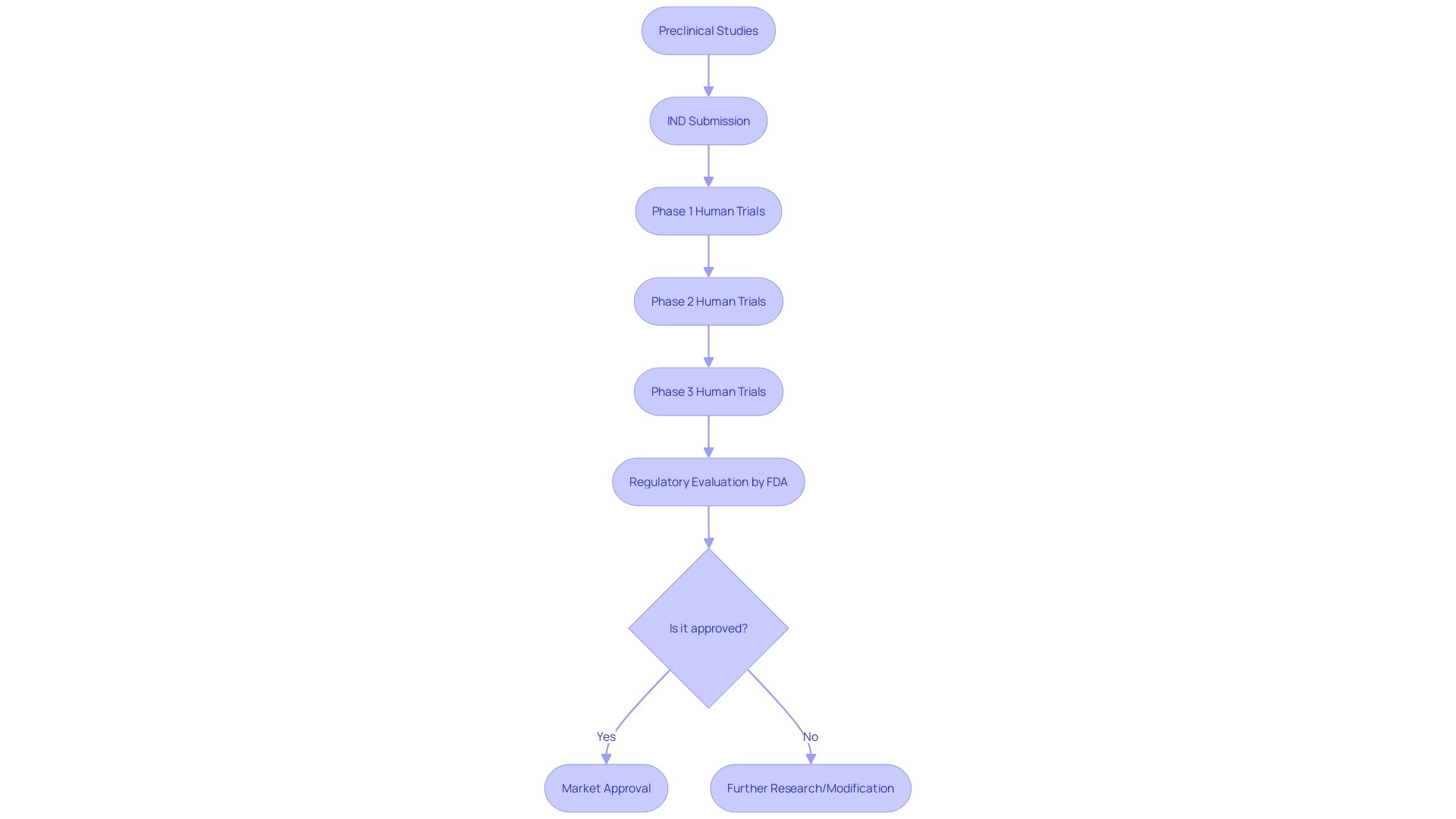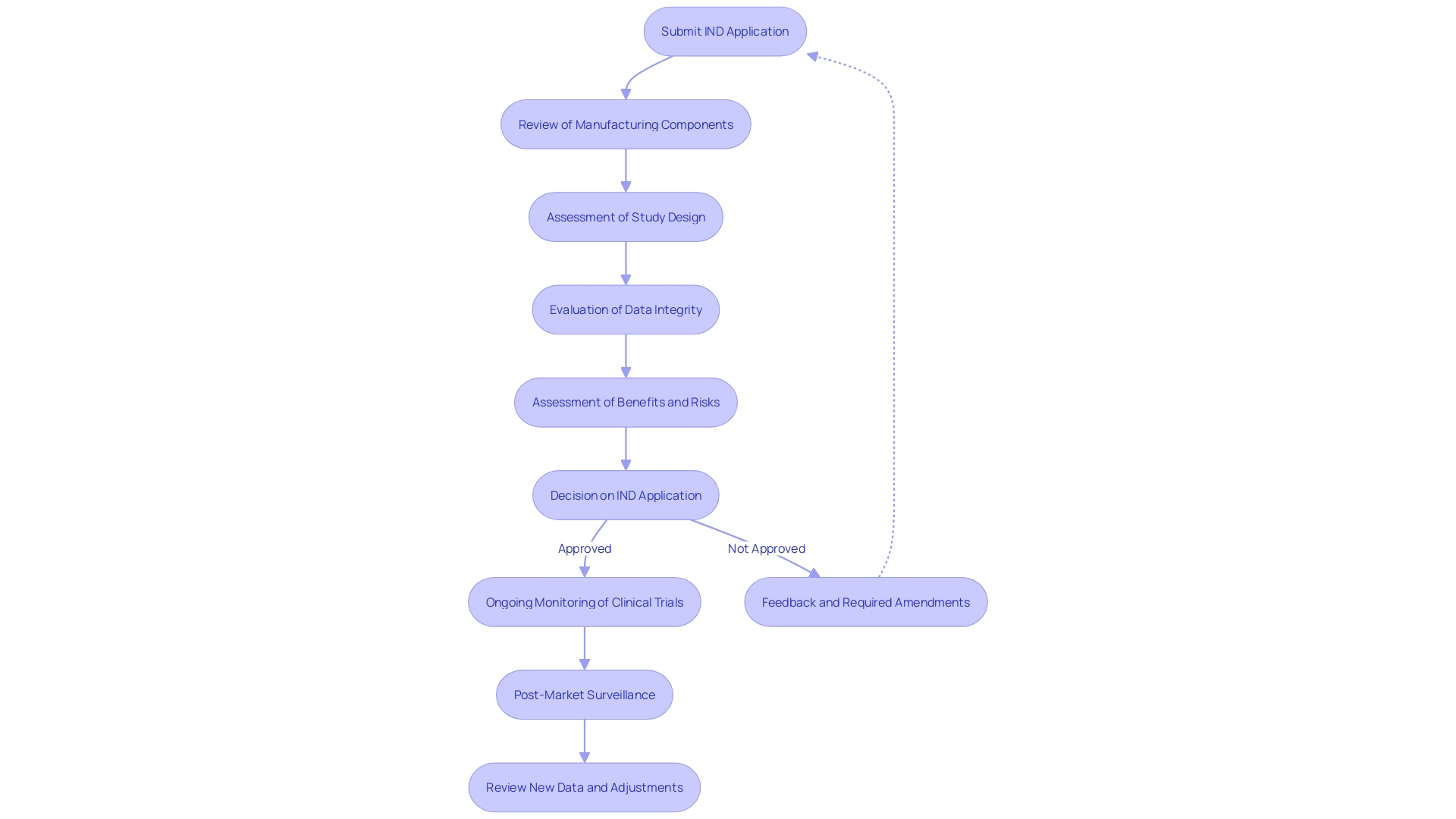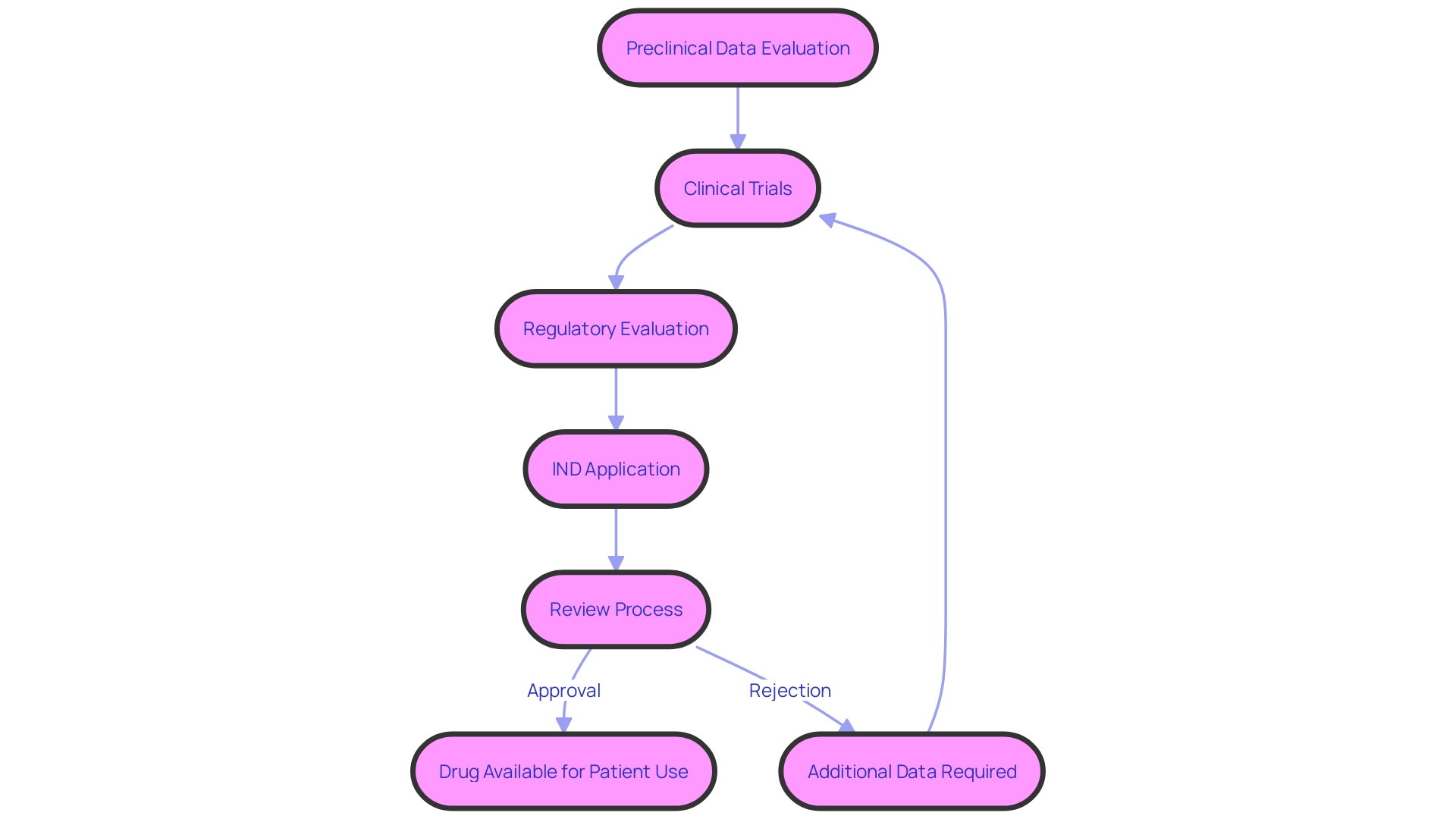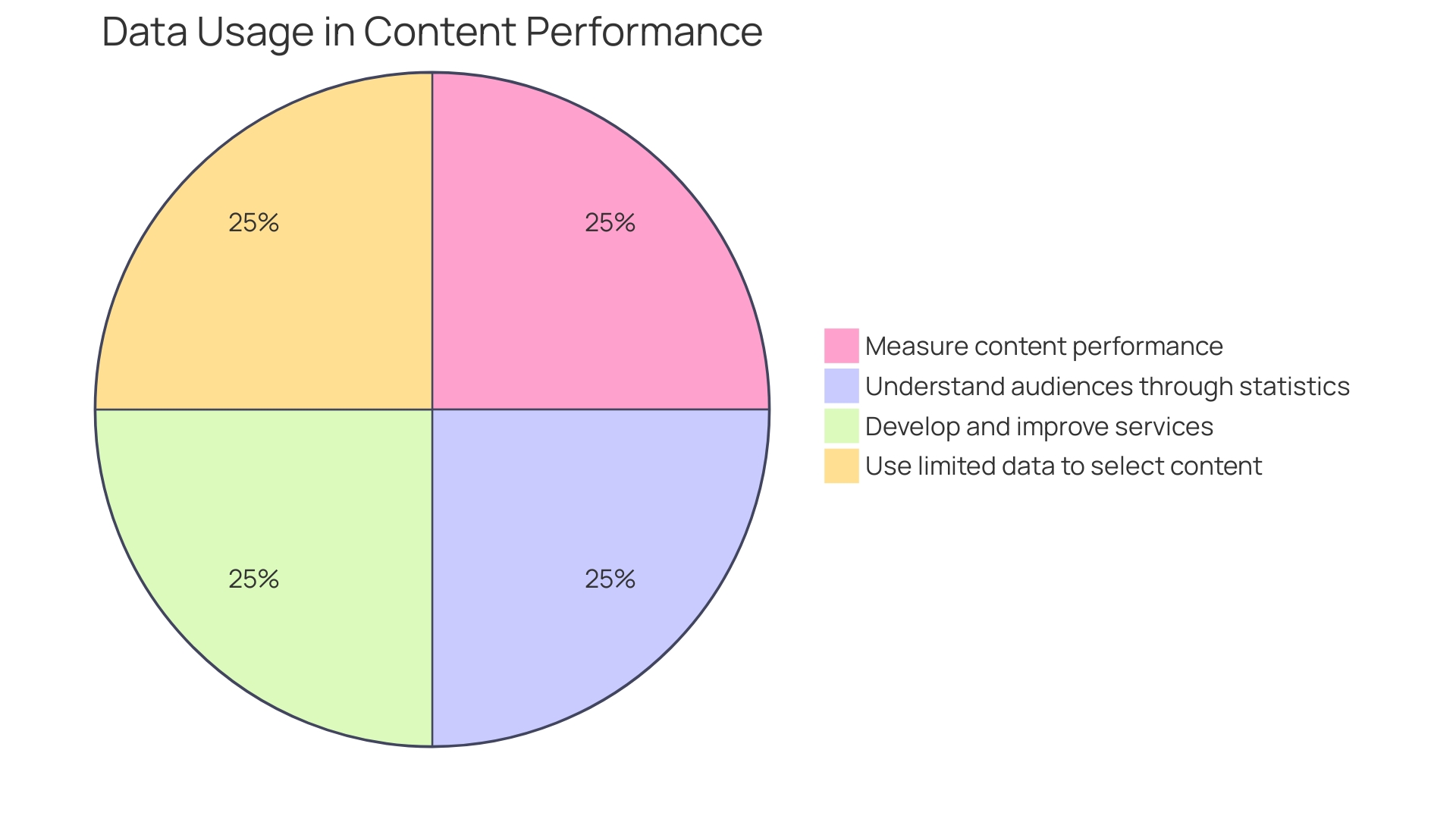Introduction
The process of bringing a new drug or biologic to market involves a critical step called the Investigational New Drug (IND) application. This application is submitted to the U.S. Food and Drug Administration (FDA) and marks the transition from preclinical studies to human testing. The IND submission provides comprehensive information about the drug's composition, manufacturing processes, proposed mechanisms, and protocols for human trials.
It undergoes a rigorous review process, reflecting the high stakes and costs involved in drug development. This article explores the purpose of an IND, the different types of INDs, the IND application process, key components of an IND application, exemptions from IND requirements, the role of the FDA in IND review, the significance of IND in medical research, and ethical considerations in IND studies. By understanding these aspects, we gain insight into the intricate and vital process of bringing new therapies to the market, while ensuring safety, efficacy, and ethical standards are upheld.
What is an IND?
Commencing clinical experiments with a new medication or biologic is a complex procedure that begins with an Investigational New Drug (IND) application to the U.S. Food and Drug Administration (FDA). This regulatory step is vital—it marks the transition from preclinical studies to the scrutiny of human testing. An IND submission must demonstrate a thorough understanding of the medication's composition, manufacturing processes, and proposed mechanisms, alongside protocols for human trials and data from animal studies to ensure safety and potential efficacy. The evaluation process is thorough, reflecting the high stakes involved in pharmaceutical development, which often spans over a decade and can cost anywhere between $340 million to $2.8 billion.
The complexities of this process can be illustrated by a case study involving Cardinal Health, which developed a comprehensive regulatory strategy for an IND submission. This approach streamlined the application, addressing ethical guidelines and obtaining necessary approvals from numerous institutional ethics committees, such as the Hospital Ethics Board of Aakash Healthcare and the Universal Ethics Committee of Aadhavvan Diabetes and Research Center, among others. Each step reinforced the meticulous detail and planning required to navigate the regulatory landscape successfully.
Furthermore, the pharmaceutical industry has seen advancements such as in silico computational modeling, which streamlines the development process. This approach, also referred to as model-informed development (MIDD), utilizes quantitative models derived from preclinical and clinical data to predict a medication's performance and clinical outcomes, ultimately assisting in decision-making and enhancing the likelihood of market approval.
Despite advances, the industry sometimes confuses scientific discovery with medication development, as highlighted in a quote that recalls how penicillin remained a laboratory curiosity for over 15 years before scalable manufacturing processes were developed. This distinction emphasizes the requirement for a concentration on development and customer value creation, as well as the acknowledgment that medication discovery requires extensive research and development to convert a breakthrough into a viable medical product.
Details regarding all CDER-approved medications and biological products, including those categorized as new molecular entities (NMEs), can be located on Drugs@FDA. These entities often represent significant advancements in therapy for patients, although some may contain active moieties similar to previously approved ingredients. FDA's designation of a medication as an NME for review purposes is a critical administrative process that is separate from determining if a product qualifies as a 'new chemical entity' under the Federal Food, Drug, and Cosmetic Act.

Purpose of an IND
The Investigational New Drug (IND) application is an important stage in the development process of a medication, necessitating a comprehensive demonstration of the investigational substance or biologic's composition, manufacturing particulars, and protocols for experimentation to the Food and Drug Administration (FDA). Such comprehensive documentation enables the FDA to meticulously evaluate the potential risks and benefits associated with the product. This process not only underpins the FDA's commitment to safeguarding public health by ensuring the safety, efficacy, and security of medical treatments but also ensures that participants in clinical trials are adequately protected.
For instance, the Impella Connect System's integration with medical devices for critical care exemplifies the stringent requirements for software functions within medical devices. These requirements include providing patient-specific information, detecting life-threatening conditions, and issuing timely alarms to healthcare providers, which necessitate premarket authorization as per section 201(h) of the Federal Food, Drug, and Cosmetic Act.
Moreover, recent FDA actions underscore the agency's dedication to enforcing compliance with federal regulations. By mandating corrective measures for identified violations and emphasizing the consequences of non-compliance, the FDA upholds its protective role. The FDA's commitment is also reflected in its recent final rule to ensure direct-to-consumer prescription medication advertisements are presented in a clear, conspicuous, and neutral manner, thus aiding consumers in making informed decisions.
The FDA's Office of Generic Drugs aims to guarantee the availability of high-quality, safe, and effective generic medications to the public. With the approval of generic medications, the agency supports increased patient access to necessary treatments while fostering a competitive market that can contribute to stabilizing the supply chain and mitigating medication shortages.
The organization's continuous endeavors, as outlined in their 2023 Annual Report, involve the approval of non-branded medications, facilitating the introduction of initial generics into the market, advancing scientific research, and enhancing international collaboration. These initiatives are part of the FDA's broader mission to protect and advance public health, cementing its role as a pivotal regulatory authority in the health care landscape.

Types of INDs
Navigating the landscape of pharmaceutical development, researchers and pharmaceutical companies encounter multiple pathways to bring their innovations to market. One such path involves the Investigational New Drug (IND) application, pivotal for trials. There are three primary IND types each serving a distinct purpose.
The commercial IND is often pursued by pharmaceutical firms aiming to eventually market a new medication or biological product. This aligns with the Center for Medication Assessment and Investigation (CMAR)’s yearly approval of a wide range of new medications, some of which represent revolutionary treatments never before seen in clinical settings.
An academic institution or investigator focusing on non-commercial research typically submits a research IND. This channel supports the scientific exploration of new treatments, where the focus is not profit, but rather advancing medical knowledge and potentially leading to patentable discoveries.
Lastly, the treatment IND is reserved for experimental substances destined for patients suffering from serious illnesses without alternative treatment options. This reflects a commitment to patient care, allowing access to potentially life-saving treatments even as they remain under investigation.
Each IND type requires a detailed submission, including components used in manufacturing, product composition, and an explanation of manufacturing processes—a process Cardinal Health successfully navigated for comprehensive and timely IND submissions.
The importance of these regulatory mechanisms cannot be overstated, as evidenced by the contributions of generics to healthcare. In 2023, generic medications remained a cornerstone in the U.S. health system, highlighting the Office of Generic Drugs' objective to guarantee access to high-quality, safe, and effective medicines, as stated in their Annual Report.
As the pharmaceutical industry evolves, driven by innovations and the relentless pursuit of meeting unmet health needs, the clarity and structure provided by the IND process play a crucial role in the introduction of new therapies to the marketplace.
IND Application Process
The submission of an Investigational New Drug (IND) application is a critical step in the development of new medicines. To initiate the procedure, sponsors must collect comprehensive data concerning the medication or biologic in question. This information, which includes comprehensive preclinical discoveries and suggested evaluation protocols, is then thoroughly examined by the FDA's Center for Drug Evaluation and Research (CDER). CDER's assessment ensures that the proposed studies are structured to meet the highest standards of safety for participants and that the potential benefits of the medication justify any risks involved.
Upon approval of the IND, sponsors can initiate clinical trials, which are continuously monitored for safety. Throughout this journey, the FDA provides indispensable guidance to sponsors, balancing the need for innovation with the uncompromising priority of patient safety. This process is not only pivotal for the progression of pharmaceutical development but also for safeguarding public health, as reflected in the FDA's mission to assure the safety, efficacy, and security of pharmaceuticals and medical devices.
In the dynamic landscape of medication approval, feedback mechanisms such as the draft guidance for industry on 'Requests for Reconsideration at the Division Level Under GDUFA' play an important role. They offer clarity and direction for sponsors navigating regulatory pathways, ensuring that the pursuit of medical breakthroughs remains aligned with the stringent standards set forth by regulatory authorities. Such guidance documents, along with the collaborative efforts of medical device experts like Etienne Nichols, aid in refining the processes that underlie the development of innovative and safe medical solutions, including combination drug-delivery devices.
Key Components of an IND Application
The intricacies of an Investigational New Drug (IND) application are crucial in the progression of research studies and the development of novel pharmaceutical compounds. The application is a comprehensive dossier that includes details on the drug's chemistry, manufacturing, and controls. It carefully outlines the investigational plan, detailing objectives, design, methodology, and proposed experiments. The dossier also encompasses pharmacology and toxicology data along with any available previous clinical trial data. IND applications ensure a clear presentation of the investigators' qualifications alongside robust safeguards for human subjects. This framework is essential for maintaining the integrity of the pharmaceutical development process and safeguarding participant welfare. To demonstrate, the application must include a comprehensive list of all components used in the medication's manufacture, their specifications, and details of the manufacturing process. It is a thorough process, ensuring that every aspect of the medication's production and anticipated medical impact is scrutinized for safety and effectiveness. As seen in recent press releases from companies like Intellia, the implications of these applications are profound, with the potential to initiate pivotal global Phase 3 studies and advance the frontier of gene editing therapies. However, they also highlight the inherent uncertainties and risks in medication development, emphasizing the need for thoroughness in IND submissions. The goal is not just to satisfy regulatory requirements but also to lay a solid foundation for clinical studies that could lead to life-changing treatments.
Exemptions from IND Requirements
Exemptions from Investigational New Drug (IND) application requirements are particularly relevant for certain entities and scenarios. For example, substances or biologics that are exclusively designed for laboratory research and not intended for human use are usually not subject to IND filings. Additionally, if a product has been previously approved for a specific use, it may not necessitate an IND when researched for a new indication. This exception is frequently relevant to orphan medications, where the U.S. Food and Drug Administration (FDA) bestows a special status under section 526 of the act. Orphan drugs are those intended to treat rare diseases or conditions and can receive an exclusive approval, prohibiting similar drugs from being approved for the same use for seven years, providing the incentive for the development of treatments for underserved patient populations.
Furthermore, events related to the manufacturing of a licensed biological product must be reported if they deviate from good manufacturing practices or applicable regulations, or if they present unexpected occurrences that could impact the product's safety, purity, or potency. These requirements are part of ensuring ongoing compliance with FDA regulations and safeguarding public health. As per the Electronic Code of Federal Regulations (eCFR), these standards are presented in a user-friendly format for convenience, although they are not the official legal edition, the eCFR is continuously updated to reflect current regulations.
Certain manufacturers and retailers, such as licensed practitioners who alter devices solely for their practice, pharmacies, and educational or research institutions that do not engage in commercial distribution, may also be exempt from the usual regulatory pathways. This can expedite the availability of necessary medical devices within specialized contexts without compromising safety and regulatory oversight.
Role of FDA in IND Review
The U.S. Food and Drug Administration (FDA) serves as a guardian of public health by rigorously overseeing the Investigational New Drug (IND) applications, pivotal to advancing medical research. This thorough evaluation procedure is essential to protect the well-being and safety of participants in clinical studies. The FDA evaluates the integrity of the submitted data, scrutinizes the design of the study, and weighs the investigational product's potential benefits against its risks. Furthermore, the FDA's role extends beyond the initial approval, as it continues to monitor the progress of ongoing trials. This vigilant monitoring is vital as it empowers the FDA to halt or terminate studies should any safety concerns emerge.
Manufacturers may propose alternative methods, but they must align with the statutory and regulatory requirements to ensure the safety, effectiveness, and security of medical products. This principle applies to a broad spectrum of FDA-regulated items, including prescription and over-the-counter medications, as well as other healthcare-related products. The FDA's dedication to public health is strengthened by the inclusion of real-time data from various stakeholders, which can prompt updates to medication labeling to reflect current safety and efficacy standards.
The agency's principal role in the medical device sector is to ascertain the safety and effectiveness of devices intended for U.S. markets. After FDA clearance, other entities such as payors and healthcare providers determine the coverage and use of the device. There is often a gap between the data required for FDA approval and what payors need for coverage decisions, which can delay patient access to new medical devices.
In gathering consumer information, the FDA employs focus groups and individual interviews to grasp consumer attitudes, beliefs, and motivations more deeply. These qualitative methods serve to develop variables for quantitative studies, understand consumer sentiments, and explore findings from quantitative research, all of which are crucial for policy development and resource allocation.
The FDA's unwavering dedication to safety is further demonstrated by the annual summary reports of the Right to Try Act, which include consolidated data on the safety determinations of investigational medications. This showcases the FDA's dependence on thorough data analysis to guarantee the safety and effectiveness of pharmaceuticals and biologics provided to the public.

Significance of IND in Medical Research
The Investigational New Drug (IND) application is a pivotal step in the journey of novel medications from the laboratory to the patient's bedside. It serves as the critical juncture where sufficient preclinical data must demonstrate that a new drug or biological agent has potential therapeutic benefits that outweigh its risks. This procedure not only ensures patient safety but also supports the rigorous testing phase, where human participants are involved for the first time.
Clinical experiments are crucial in shaping the future of healthcare, providing deep insights into disease mechanisms and treatment effects. For instance, in one remarkable experiment, individuals who were previously deemed fit found hidden health problems, highlighting the unexpected advantages of scientific investigation. In another example, notable progress was achieved through studies on beta-blockers, revealing a 3% absolute risk reduction in mortality, highlighting the life-saving potential of well-executed studies.
Technological innovations have transformed the experimentation landscape, with digital tools and wearable devices enabling real-time, accurate data collection, minimizing human error, and expediting the analysis process. This efficiency is crucial as companies navigate the complex regulatory environment to bring new treatments to market. The FDA's Center for Drug Evaluation and Research (CDER) plays a central role in guiding developers, making clear the scientific rigor and data required for a comprehensive evaluation of new therapeutic agents.
As new treatments advance through the evaluation process, the significance of context becomes evident. The effectiveness of a product is not a standalone attribute but one that is inherently tied to its intended use, as defined by trial design and subsequent regulatory labeling. This context-oriented approach is demonstrated by Intellia's forward-looking statements regarding their investigational gene editing therapy, NTLA-2001, showcasing the dynamic and evolving nature of medical research in the quest to meet unmet medical needs.
Ultimately, the IND process is a testament to the collaborative effort between researchers, regulators, and participants, all striving towards the common goal of advancing healthcare and offering new horizons of hope for patients worldwide.

Ethical Considerations in IND Studies
Ethical guidelines in clinical research, particularly for Investigational New Drug (IND) studies, are paramount for safeguarding participant welfare. It's imperative that participants have a comprehensive understanding of both the risks and the benefits before giving informed consent. Researchers are responsible for ensuring informed consent and continuously monitoring the investigational product for safety and efficacy throughout the duration of the study.
Respecting participant autonomy and ensuring their safety echo the principles outlined in Indigenous-led research projects, as reported by Morisano et al. (2018), who emphasized the importance of engaging with participants in a manner that honors their governance and culture. This approach resonates with international research ethics, which demand that studies, especially those involving vulnerable populations, are conducted with utmost respect and collaboration, ensuring that research outcomes are beneficial to the community involved.
This ethical mandate is further complicated by the potential long-term implications of participating in a study. For instance, in a hypothetical scenario put forward by Hendriks, a participant underwent a life-enhancing brain implant during an experiment, which stopped working after the study due to the company's bankruptcy, emphasizing the ethical responsibility researchers have to take into account the sustainability and post-experiment access of investigational products.
Furthermore, the difference in research study allocation between high-income countries (HICs) and low- and middle-income countries (LMICs) highlights the moral obligation to guarantee fair access to the advantages of research. Based on the statistics for 2022, there is a significant disparity in the number of trials carried out in these areas, with fewer than 5% of trials including pregnant women and only 13% involving children, which further emphasizes the necessity for inclusive and ethically designed research.
Overall, the ethical considerations in medical studies go beyond mere compliance; they require a dedication to the dignity, rights, and welfare of the participants, as well as to the integrity of the research process itself. This is a crucial aspect of any clinical study, with the potential to significantly impact the trustworthiness and utility of the research data obtained.

Conclusion
In conclusion, the Investigational New Drug (IND) application is a critical step in the drug development process, transitioning from preclinical studies to human testing. It provides comprehensive information about the drug's composition, manufacturing processes, proposed mechanisms, and protocols for human trials. The FDA's rigorous review process ensures safety and efficacy in drug development.
The purpose of an IND is to safeguard public health by evaluating the potential risks and benefits associated with the product. The FDA's commitment to enforcing compliance with regulations and recent initiatives demonstrates its dedication to advancing healthcare and ensuring patient access to necessary treatments.
There are three primary types of INDs: commercial INDs for pharmaceutical firms, research INDs for academic institutions or investigators, and treatment INDs for experimental drugs. Each type requires a detailed submission and plays a crucial role in introducing new therapies to the marketplace.
The IND application process involves gathering comprehensive data and submitting it to the FDA for review. The FDA's assessment ensures the highest safety standards and justifies the potential benefits of the drug. Ongoing monitoring of clinical trials further emphasizes the FDA's commitment to patient safety and public health.
Key components of an IND application include details on the drug's chemistry, manufacturing, and controls, as well as objectives, design, methodology, and proposed clinical trials. IND applications lay a solid foundation for clinical studies that could lead to life-changing treatments.
Exemptions from IND requirements exist for certain entities and scenarios, expediting the availability of necessary medical devices within specialized contexts without compromising safety.
The FDA plays a crucial role in the review of IND applications, evaluating the data, scrutinizing study design, and monitoring ongoing trials. Its commitment to safety and effectiveness extends to various FDA-regulated items, ensuring continuous improvement of regulatory standards.
The significance of INDs in medical research is paramount, ensuring patient safety, advancing healthcare, and providing deep insights into disease mechanisms and treatment effects.
Ethical considerations in IND studies focus on securing informed consent, monitoring participant welfare, and ensuring equitable access to the benefits of research.
In summary, the IND process is vital for bringing new therapies to the market while ensuring safety, efficacy, and ethical standards. It requires comprehensive documentation, rigorous review, and ongoing monitoring to protect public health and advance medical knowledge. The collaborative effort between researchers, regulators, and participants shapes the future of healthcare.




